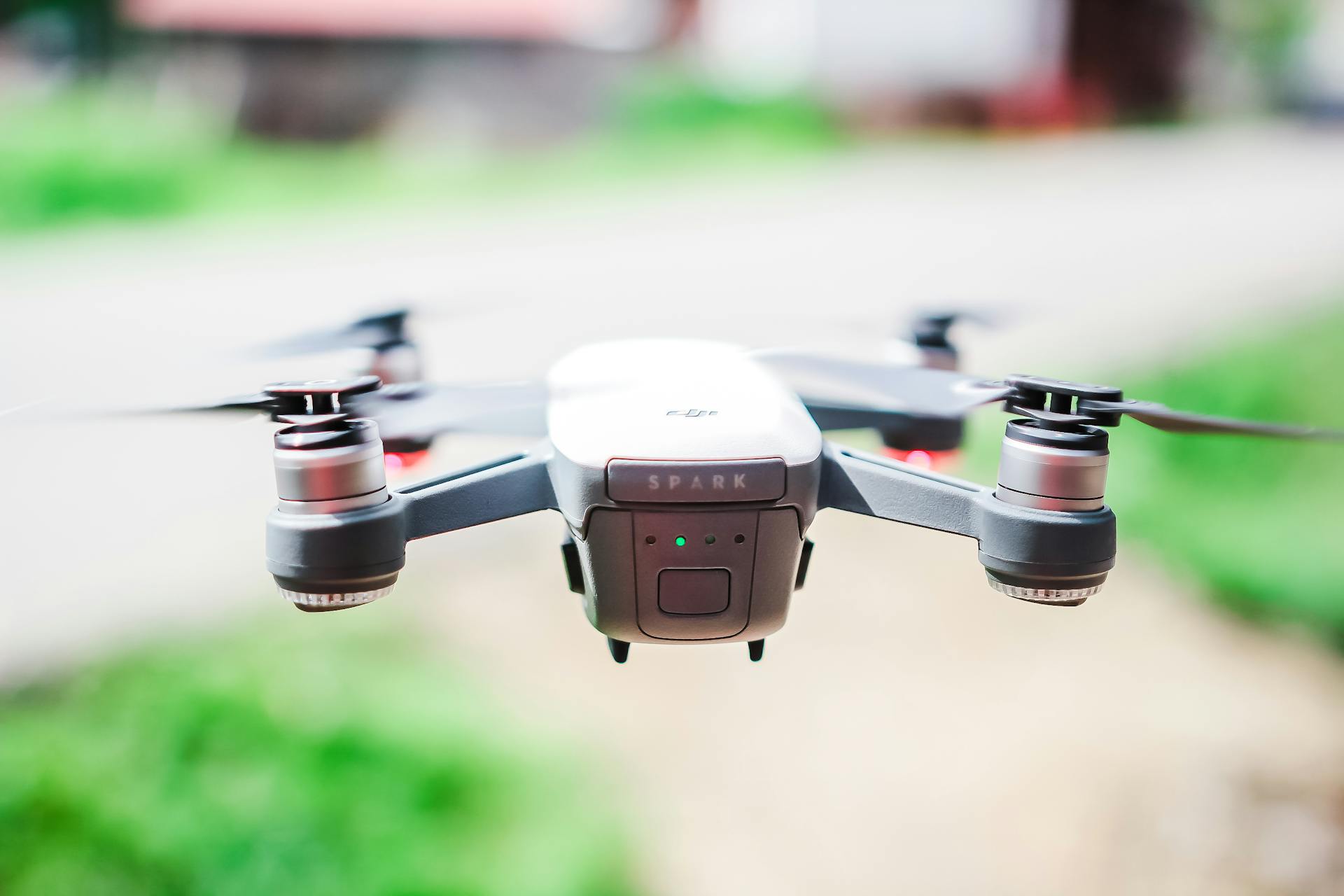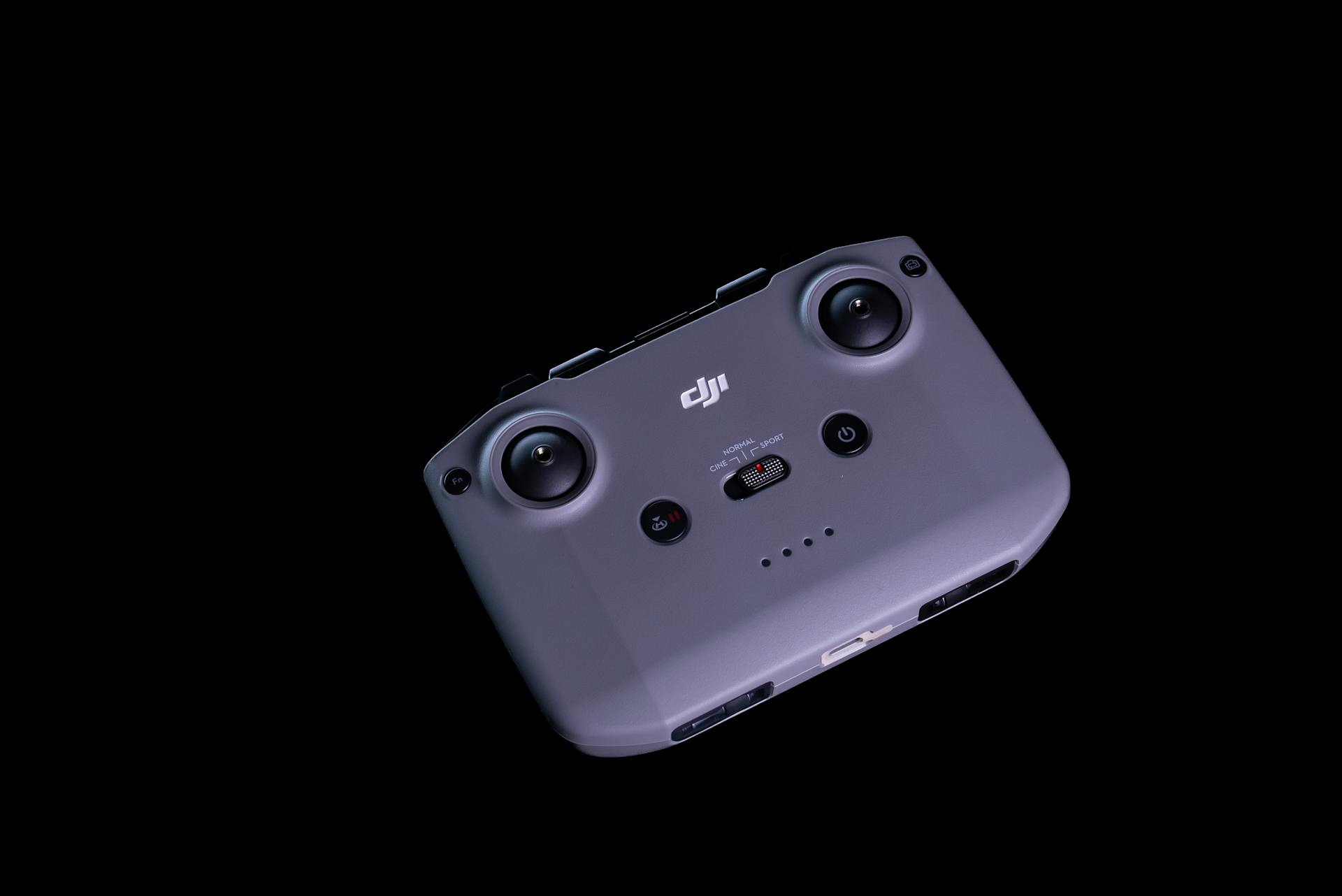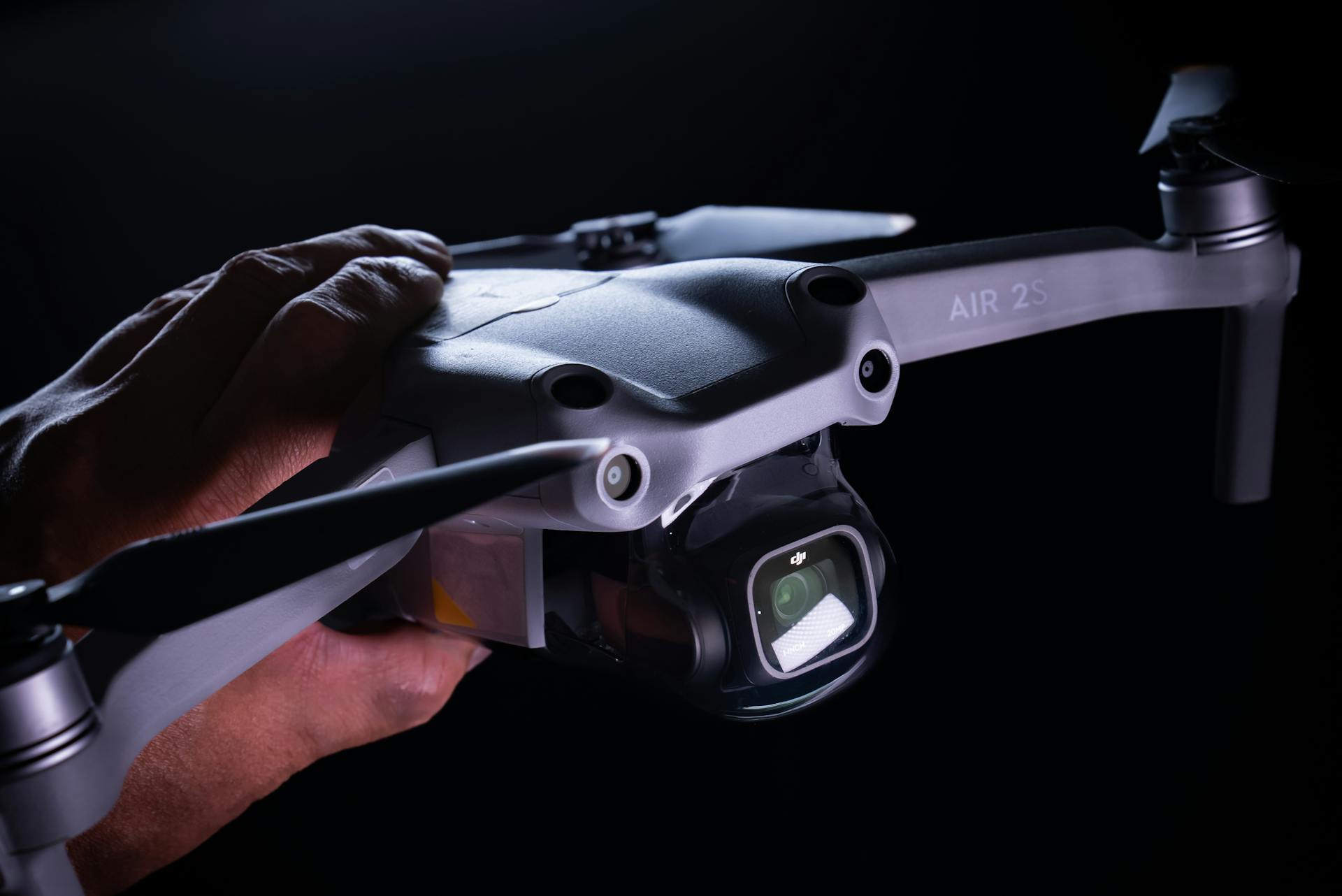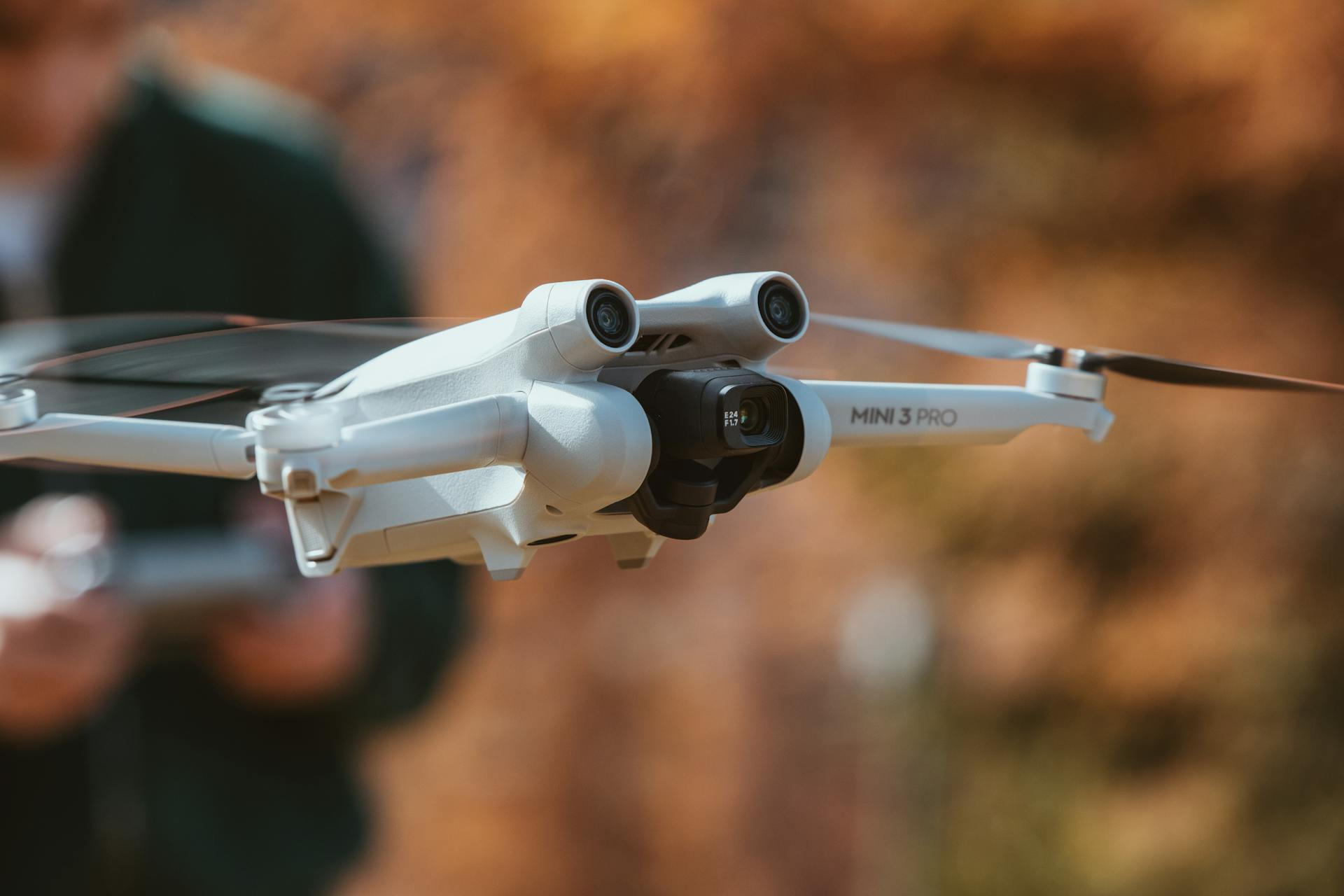
DJI, a Chinese technology company, has revolutionized the drone industry with its innovative products and services. Founded in 2006, DJI has grown to become the world's largest drone manufacturer, known for its high-quality and reliable drones.
DJI's impact on the drone industry is evident in its market share, which has consistently dominated the global drone market. In 2017, DJI held a 70% market share, surpassing its competitors.
DJI's commitment to innovation has led to the development of a range of drones, from consumer-grade models to professional-grade ones. These drones have been used in various industries, including filmmaking, surveying, and agriculture.
DJI's drones have also been used in search and rescue operations, such as the 2017 California wildfires, where they helped emergency responders locate people in need of assistance.
A unique perspective: Dji - Mini 2 Se Drone with Remote Control
Company History
DJI was founded in 2006 by Frank Wang, who was born in Hangzhou, Zhejiang.
Wang built the first prototypes of DJI's projects in his dorm room at the Hong Kong University of Science and Technology (HKUST), where he was part of a team that won third prize in the ABU Robocon.
The company struggled initially, with a high degree of employee churn attributed to Wang's abrasive personality and perfectionist expectations.
Wang used the proceeds from selling flight control components to universities and Chinese electric companies to move to the industrial hub of Shenzhen and hire a small staff in 2006.
The company received financial support from Wang's family friend, Lu Di, who provided US$90,000 and managed the company's finances.
In 2010, DJI began to cater more to drone hobbyists in markets outside of China after Wang hired a high school friend, Swift Xie Jia, to run the company's marketing.
In 2011, Wang founded DJI North America, a subsidiary company focusing on mass market drone sales, with Colin Guinn.
The Phantom, released in 2013, was a commercially successful entry-level drone that was more user-friendly than other drones on the market at the time.
However, the Phantom's success led to conflict between Guinn and Wang, resulting in Guinn's eventual departure from the company.
DJI released the Phantom 3 in 2015, which eclipsed the success of the original Phantom and featured a built-in live-streaming camera.
Explore further: Dji Osmo Company
This was also the year DJI established the RoboMaster Robotics Competition, an annual international collegiate robot combat tournament held at the Shenzhen Bay Sports Centre.
In 2017, DJI won a Technology and Engineering Emmy Award for its camera drone technology, which was used in the filming of various television shows.
That same year, Wang became Asia's youngest tech billionaire and the world's first drone billionaire.
Corporate Overview
DJI has a significant corporate structure with a large employee base, counting roughly 14,000 employees.
The company has a highly competitive internal culture where teams are often pitted against each other to design better products.
Corporate Structure
DJI is a significant player in the industry, with a workforce of roughly 14,000 employees.
The company has a complex corporate structure, having received investment from various sources, including state-owned entities such as New China Life Insurance and China Chengtong Holdings Group.
DJI's funding rounds have been substantial, with a $1 billion raise in 2018 and a $500 million raise in 2015 from investors like GIC and New Horizon Capital.
These investments have helped DJI expand its global presence, with 17 offices internationally.
The company's factories in Shenzhen feature highly sophisticated automated assembly lines, with many components built in-house.
DJI's hiring process is notoriously difficult, and its internal culture is extremely competitive, with teams often pitted against each other to design better products.
Zoom Enterprise Plans
Zoom Enterprise Plans are designed for businesses that need advanced features and capabilities. The DJI Mavic 2 Zoom has a 4× zoom feature, with 2× optical and 2× digital zoom.
The drone's camera is 12-megapixels, making it suitable for applications that require high-quality imaging. The Mavic 2 Zoom can record 4K video at 30 FPS.
DJI's enterprise series, including the Mavic 2 Enterprise, Mavic 2 Enterprise Dual, and Mavic 2 Enterprise Advanced, offer various accessories for first responder and industrial applications. The Mavic 2 Enterprise includes the Spotlight, Speaker, and Beacon.
The Mavic 2 Enterprise Dual features a thermal camera from FLIR, while the Mavic 2 Enterprise Advanced has an improved thermal camera sensor and a 48-megapixel 1⁄2 in (13 mm) camera sensor.
The DJI Mavic 3 Enterprise edition uses the DJI RC Pro Enterprise controller, which includes a microphone. The drone's weight is 915 or 920 g without accessories.
For your interest: Dji Phantom 4 Pro Drone Accessories
Return
The Mavic Air series has undergone significant improvements over the years. The Mavic Air, released in 2018, can capture 4K video at 30 FPS.
One notable feature of the Mavic Air is its 21-minute flight time, thanks to the antennas mounted on its landing gear. It also has a range of 2.5 miles.
The Mavic Air 2, released in 2020, boasts a 1/2 inch CMOS camera, which is a significant upgrade. The Air 2 can travel up to 68.4 km/h.
The Air 2's remote controller features a new design, with a mount that holds the smartphone at the top, more in line of view. This design change improves the user experience.
The Air 2 upgrades to Ocusync 2.0, a dedicated radio system that runs in the 2.4 GHz and 5.8 GHz ranges, reducing interference from ambient Wi-Fi networks. This results in a better range of up to 10 kilometers.
The Mavic Air 2 supports RAW format, 48 MP mode, HDR video, and Hyperlapse 240 fps slow-motion mode, making it a powerful tool for filmmakers.
Recommended read: Range on Dji Phantom 3
3S
The DJI Air 3S is an updated version of the Mavic Air 3, released in October 2024.
It has a weight of 724 g, which is a slight increase from its predecessor.
The Air 3S features two cameras, including a 1-inch CMOS sensor camera capable of shooting 4K video at a maximum frame rate of 60 FPS.
This camera is a significant upgrade from previous models, allowing for high-quality video capture.
With a maximum flight time of 45 minutes, the Air 3S can capture a lot of footage in a single session.
It also features OcuSync 04, which allows for up to 20 km of range.
Curious to learn more? Check out: Dji Mini 2 Se Camera Drone with Remote Controller Bundle
Buying Drones in the Future
You can still buy DJI drones and products, but it might be a bit more challenging. The fact that DJI is on the Entity list doesn't automatically mean they'll be pulled from store shelves.
Many top retailers have stopped selling Huawei phones since they were blacklisted, but Huawei phones are still available to American citizens. It's just that they're harder to find.
In the case of DJI, it's likely that some retailers will continue to sell their products, but it's uncertain how long that will be possible. The situation is similar to Huawei, where phones are still available, but it's difficult to find them in stores.
It's worth noting that the availability of DJI drones and products may vary depending on the retailer and the specific product. Some retailers might choose not to sell DJI products at all, while others might continue to do so.
Drone Technologies
DJI's drone technology has evolved significantly over the years, with the company releasing popular models like the DJI Phantom 4 in 2016.
The DJI Phantom 4 was a quadcopter with a quad-rotor configuration and supported 4-8 motors.
DJI's drones have varying hovering accuracy, with the DJI Phantom 4 having a vertical accuracy of ±0.5m and a horizontal accuracy of ±1.5m.
Some DJI drones, like the DJI Phantom 4, have built-in receivers, while others, like the Naza V2, do not.
Here is a comparison of some DJI drone models:
The DJI Mavic series has also become popular, with models like the Mavic Pro and Mavic Air offering advanced features and capabilities.
See what others are reading: Dji Innovations Mavic Pro
Drone Technologies
The DJI Phantom 4 was a popular drone model released in 2016, marking a significant milestone in drone technology.
One key feature of drone technology is the number of motors supported, with some models capable of supporting up to 8 motors, like the DJI Phantom 4.
The DJI Phantom 4, for example, has a built-in receiver operating on 2.4 GHz frequency.
Drone hovering accuracy is also an important aspect, with some models able to maintain a vertical accuracy of ±0.5m and horizontal accuracy of ±1.5m, like the DJI Phantom 4.
Here's a comparison of some drone models' hovering accuracy:
The DJI Phantom 4's motor-rotor configuration is a quad-rotor, capable of supporting various motor arrangements, including +4,X4.
The Naza V2, on the other hand, is a quad-rotor model with a different motor-rotor configuration, I4, X4.
The DJI Phantom 4's built-in receiver and quad-rotor configuration make it a reliable and versatile drone model.
Stabilized Cameras
The DJI FPV drone features the latest safety features for greater flight control, including the stabilization of RockSteady electronic image stabilization.
This allows pilots to capture ultra-smooth and stable 4K video at 60 fps, making it ideal for capturing high-quality footage.
The RockSteady electronic image stabilization technology provides a more stable and smooth video feed, reducing the need for manual adjustments.
This results in a more professional-looking video, perfect for a variety of applications such as filmmaking, photography, and more.
Drones
Drones have become increasingly popular in recent years, and it's no wonder why. With their ability to capture stunning footage and photos, they've become a favorite among hobbyists and professionals alike.
One of the most popular drone models is the DJI Mavic series, which includes models like the Mavic Pro, Mavic Air, and Mavic 3. These drones are known for their portability and small size, making them easy to take on the go.
The Mavic Mini, released in 2019, is a great example of a portable drone. Weighing in at just 249 grams, it's small enough to fit in a pocket or bag, and its 12 MP camera can capture stunning 2.7K video.
The DJI Mini 2, released in 2020, improves upon the Mavic Mini with longer flight time (31 minutes) and the ability to record 4K footage. Its 5 quickshot modes and 3 panorama modes make it a great option for capturing a variety of shots.
Here's a comparison of some of the DJI Mini models:
It's worth noting that while drones like the Mavic Mini and Mini 2 are great for recreational use, they're not designed for military or professional use. In fact, DJI has prohibited the export of their products for military purposes, and they've been used extensively by Ukrainian and Russian forces during the Russian invasion of Ukraine.
Suggestion: Dji Drone Military
Third Party SDK Support
DJI supports a mobile SDK for developing Android and iOS applications for use with DJI Enterprise drones.
This SDK allows developers to create custom applications that can be used with DJI drones, enabling a wide range of possibilities such as mission planning and photogrammetry.
Some of the drones are also supported by UX SDK and Windows SDK, which suggests that DJI is committed to providing a broad range of SDK options for developers.
In 2022, DJI stated they are prioritizing enterprise-level aircraft, indicating a focus on supporting businesses and organizations that rely on drones for their operations.
SDK version 5 for Mavic 3 and Mini 3 series were released only with Android support, while older drones used SDK version 4 which had support for iOS and Android.
Examples of third-party applications that utilize DJI's SDK include mission planning, photogrammetry and mapping apps such as Lichi, DroneDeploy, Pix4D and Dronelink.
Frequently Asked Questions
Who owns the company DJI?
DJI was founded by Frank Wang Tao, a Chinese developer, in 2006. The company is privately owned by its founder and his team.
What does the DJI company do?
DJI specializes in designing and manufacturing commercial drones for capturing high-quality aerial photos and videos. Their innovative drones are used in various industries for aerial photography and videography applications.
Is DJI a good company to work for?
Based on 240 anonymous reviews, DJI employees rate the company 3.8 out of 5 stars on Glassdoor, indicating a generally positive work experience. However, individual experiences may vary, and more information is needed to form a complete picture.
What does the DJI stand for?
DJI stands for Da-Jiang Innovations, a name that reflects the company's mission to push the boundaries of innovation and exploration.
Featured Images: pexels.com


